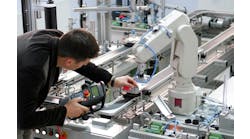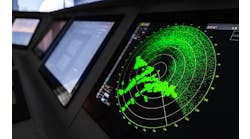A Control Design reader writes: We had downtime on a production machine due to failure of a presence sensor recently. The inductive sensor that failed had a unique form factor and was embedded in a part nest. My boss was not happy; production shut down for a day because the $37 "special" sensor couldn't be found in stock anywhere.
To keep this from happening in the future, the boss suggested we replace all nonstandard presence sensors with either a 12-mm barrel inductive proximity sensor, a diffused photo eye or some type of fiberoptic sensor. I don't think it is as simple as that and want to develop a document for presence-sensor standards and best practices that will help to define upgrades and future new equipment. What do you suggest?
What are the handful of sensors that can do it all for presence sensing in machine-control and part-handling applications?
ANSWERS
Form factor
Standardization is very important when selecting object-detection sensors; we see that in most factory-automation applications. There are just a few sensor technologies needed for rock-solid error proofing or even machine positioning.
Inductive sensors: Used for most applications where short range detection is needed and a ferrous material is present. This can be a part itself or used for machine position location.
Photoelectric sensors: Used in most applications where more range is needed. Photo sensors can detect ferrous and nonferrous materials and are offered with different light sources, depending on the application need.
Magnetic-field sensors: Magnetic-field sensors are commonly used with pneumatic air cylinders and grippers to verify position. These devices read a magnet through the aluminum cylinder wall/housing.
Capacitive sensors: Capacitive sensors are much like an inductive sensor as they offer short-range detection. However, they are more suited for nonferrous material such as wood or glass.
After the correct sensor technology for the application has been selected, the correct form factor is needed. In most applications an M08-M18 will cover it. Inductive, photoelectric and capacitive sensors all come in those common form factors with optional output selections to accommodate any type of controls architecture.
Shawn Day / marketing manager / Balluff
No universal standard
Unfortunately, there is not a universal standard for all sensor products, and the performance of competitive products not always are exactly the same. From a housing stand point we suggest the following:
• For limit-switch applications, we recommend to use products that follow CENELEC EN 50041. This will ensure the devices have the same mounting pattern and actuation. In most cases, this means simplified replacement.
• For electronic sensors such as inductive, capacitive, ultrasonic and photoelectric, we recommend to use standard cylindrical diameters such as M8, M12, M18 and M30. This cylindrical universal housing allows more interchangeability with products from multiple vendors. Always use M12 and M8 connectors that allow you an easy replacement without having to rewire the sensors.
If you follow these basic rules, you will have a more flexible plant or machine. Always remember that the performance of products differs greatly between vendors, so always be sure to check the specs before purchasing.
Luis Torralva / Telemecanique Sensors sales & marketing manager / Schneider Electric
Standardize
Shutdowns are never fun, especially when it’s for a relatively inexpensive part that should be readily available. There are a few things you can do to limit your exposure to these situations.
First, standardize on a series of sensors from a reputable manufacturer. You can find photoelectric sensor series that have many different sensing modes and ranges available for all your applications. This provides consistency in programming, and it limits the number of different sensors on your line. When selecting the series, let your salesperson know you want a standard series that is well-established and not at the end of its lifecycle.
Another option we have seen customers utilize is to standardize on a sensor that has multiple sensing options built in and that can detect targets no matter the color, sheen, or opacity. These versatile problem-solving sensors are easy to standardize on and can solve almost any application. Some of these sensors also come with IO-Link communication, so your sensor settings can be stored. If a sensor needs to be replaced, all you need to do is hook up a new one. Your configurations are automatically uploaded, and you are back up and running immediately.
Once you decide on a series that will meet your needs, consider having a few on the shelf for emergencies, or have your local distributor have safety stock on hand. Good luck.
Dana Holmes / business development manager—sensors / Banner Engineering
Standard mounting
When designing a machine, sticking to industry-standard mounting conditions can do a lot to minimize downtime. Most standard machine-control and part-handling applications can be solved using either inductive or photoelectric sensors. Each sensor family has a few housing styles that can provide all required functionality while allowing easy device replacement.
For inductive sensors, 12-mm, 18-mm, and 30-mm cylindrical models are the most common. These models can cover most range requirements and are likely to be in stock at the manufacturer or distributor. The large variety of components in these housing styles also makes it more likely that a close replacement will be available if a direct drop-in is not.
When it comes to photoelectric sensors, housings are less standard from manufacturer to manufacturer, but mounting is generally standardized. The front, thru-hole mounting style is standard for small and large rectangular photoelectric sensors. Another popular mounting configuration is threading into an 18-mm diameter hole. Both rectangular and standard cylindrical models have been designed to fit this arrangement. Some companies are now also creating platform housings that offer all photoelectric sensing modes within the same footprint. This means that a standard mounting can now meet even more complex applications that in the past would have required a unique sensor.
Standardizing on a sensor housing style can have major benefits for a company. It can help to increase uptime by making sensor replacement much easier. It can also simplify the design process, making your products more cost-effective. Most importantly, all of this can be achieved without sacrificing functionality.
Colton Rentsch / account manager, factory automation / Pepperl+Fuchs
Sensing range
Although we would agree with your production manager, each case must be investigated individually. In the example you describe below, a 12-mm proximity switch with PNP wiring would probably be your most cost-effective option. An inductive sensor could be used to provide extended sensing range and automatically sense whether the sensor is wired PNP or NPN. Many OEMs design their products with a specific sensor in mind, so you have to make sure that the physical space allows a generic 12-mm proximity switch. Also, you need to investigate the sensing range required to make sure that you are getting the functionality your machine needs.
Eaton's Series 101 Learning course on sensors (www.controldesign.com/sensorbasics) covers the fundamentals of proximity switches, photoelectric sensors and limit switches. Some of the advice it offers for evaluating sensors and replacements follows.
Sensors are devices that sense the presence or absence of objects. The sensor gathers that information and converts it into a signal that can be read and/or seen by an observer or a piece of equipment.
Sensors are used in everyday applications such as cars, machines, manufacturing and robotics. Within these applications, sensors perform a number of functions.
Sensors can be thoughts of as automatic switches. In a factory, a sensor can be used to detect a problem on the production line and stop the process automatically. No human intervention is necessary.
Limit switches use contact with the actuator to either open or close the circuit. Proximity sensors use an electromagnetic field to detect the presence or absence of an object. And photoelectric sensors use light to detect the presence or absence of an object.
A limit switch is a mechanical device that requires the physical contact of an object with the switch's actuator to make the contacts change state (open/closed). As the object or target makes contact with the operator of the switch, it eventually moves the actuator to the limit where the contacts change state. In a normally closed (NC) circuit, this mechanical action opens the electrical contacts and in a normally open (NO) circuit, it closes them. The contacts then start or stop the flow of current in the electrical circuit.
When the actuator is at its initial position, the limit switch contacts are in their normal unactuated positions. Contact is made with the target object and the actuator moves its pre-travel distance. The actuator reaches its operating point where the contacts are changed from their unactuated position to their actuated position.
As with all devices, the limit switch has its strengths and weaknesses.
Its strengths include:
-
can be used in almost any industrial environment because of its rugged design
-
can switch high inductance loads up to 10 A
-
very precise in terms of accuracy and repeatability
-
low cost.
Its weaknesses include:
-
moving mechanical parts wear out
-
must touch target to sense
-
relatively slow (5 times/s) compared to electronic devices.
Limit switches consist of three main components:
-
actuator/operating head, which physically comes in contact with the target
-
switching body, which contains the electrical contact mechanism
-
receptacle/terminals, such as the terminal screw or screw/clamp necessary for wiring.
The standard industrial switch is the first choice for industrial applications due to the fact it can be subjected to oil, grease, dirt, high-pressure washdown, shock and vibration.
The arcing inside the hazardous duty switch will not escape the limit switch to ignite the environment where it's being used.
A precision limit switch is widely used in commercial and industrial application. It's often chosen for precise operating characteristics, small size and low cost.
Proximity sensors use an electromagnetic field to detect when an object is near. There's no physical contact between the object and the sensor. This type of sensor is generally used to sense at distances less than 1 inch.
Inductive proximity sensors detect only metal objects. And capacitive proximity sensors can sense both metallic and nonmetallic objects.
Inductive proximity sensors are useful for precise detection in the following applications:
-
machine tool applications for the detection of tool presence
-
detecting metal bottle caps in food and drink production
-
detecting the position of the moving parts of automated assembly equipment to allow programmable logic controllers (PLCs) to sequence their operations.
Proximity switches have strengths and weaknesses.
Its strengths include:
-
immune to adverse environmental conditions
-
high switching rate for rapid response applications
-
can detect metallic targets through nonmetallic barriers
-
long operational life with virtually unlimited operating cycles
-
solid-state to provide a bounce-free input signal to PLCs and other solid-state logic devices.
Its weaknesses include:
-
limited sensing range (100 mm maximum)
-
detects only metal objects
-
may be affected by metal chips accumulating on sensor face.
The four main factors when selecting and applying proximity sensors are target considerations, such as material, size, shape and approach; coil size and shielding; sensor mounting requirements; and environment.
Danny Weiss / senior product manager / Newark element14
Matt Simms / product manager / Eaton






